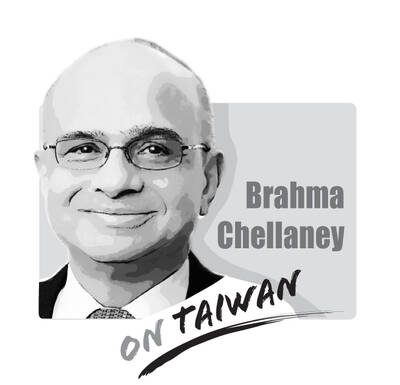Since Tsai Ing-wen (蔡英文) of the Democratic Progressive Party (DPP) was elected president on Jan. 16, China has made no secret of pressuring her to include the so-called “1992 consensus” in her inauguration speech on Friday, threatening “earth-shattering consequences” if it is not adopted as the basis for cross-strait relations.
The outgoing Chinese Nationalist Party (KMT) government claims the “consensus” refers to a tacit understanding reached between Taipei and Beijing in 1992 that both sides of the Taiwan Strait acknowledge there is “one China,” with each side having its own interpretation of what “one China” means.
What if Tsai — who has repeatedly reiterated the DPP’s position recognizing that a meeting between Taiwan and China took place in 1992, but rejecting the notion that a consensus was reached — were to accept the “1992 consensus”? Would China be satisfied? Would the two sides of the Taiwan Strait resolve their differences and live happily ever after?
The answer is “No” — as evidenced by China’s incessant obstruction and belittlement of Taiwan on the international stage over the past eight years, despite the acceptance of the fictitious consensus by President Ma Ying-jeou’s (馬英九) China-friendly administration.
The Ma government has for eight years happily toed Beijing’s line by constructing its entire cross-strait policy on the fabricated “1992 consensus,” but what has Taiwan received in return?
Not only has it veered the nation toward China’s “one China” framework, but nowhere has the Taiwanese public seen the Ma government’s acceptance of the fictional consensus conjured up by former National Security Council secretary-general Su Chi (蘇起) resulting in less obstruction and marginalization of Taiwan by China.
Instead, Taiwan has seen its national dignity downgraded on the international stage, because Ma’s narrative that the “1992 consensus” allows Taiwan more room to maneuver simply does not sit well with members of the international community, which overwhelmingly sees the People’s Republic of China as the sole, legitimate representative of China.
Ma and the KMT may be quick to tout the consensus as the main factor enabling Taiwan to attend meetings of international bodies such as the WHO, but even with such participation, Taiwan has to fight a constant battle against efforts by Chinese officials to downgrade its status.
Adopting the “consensus” has allowed China to oppose Taiwan’s international participation countless times by citing the “one China” principle.
The Ma government’s employment of the “1992 consensus” over the past eight years has not in any way altered China’s objective of bringing Taiwan under its control.
In fact, the opposite is more likely true: The Ma government’s touting of the “1992 consensus” only works to serve China’s political agenda by downgrading the Republic of China’s standing on the international stage and drawing Taiwan closer toward unification with China.
The essence of the so-called “1992 consensus” lies in China’s true ambition, which is to annex Taiwan under the “one China” principle.
So, while China has in recent days attempted to paint Taiwan as an exporter of telephone fraud rings that target people in China, the truth is China is itself the biggest fraud artist of all, wrapping the “one China” poison pill in the illusion of the so-called “1992 consensus.”

Taiwan stands at the epicenter of a seismic shift that will determine the Indo-Pacific’s future security architecture. Whether deterrence prevails or collapses will reverberate far beyond the Taiwan Strait, fundamentally reshaping global power dynamics. The stakes could not be higher. Today, Taipei confronts an unprecedented convergence of threats from an increasingly muscular China that has intensified its multidimensional pressure campaign. Beijing’s strategy is comprehensive: military intimidation, diplomatic isolation, economic coercion, and sophisticated influence operations designed to fracture Taiwan’s democratic society from within. This challenge is magnified by Taiwan’s internal political divisions, which extend to fundamental questions about the island’s identity and future
The narrative surrounding Indian Prime Minister Narendra Modi’s attendance at last week’s Shanghai Cooperation Organization (SCO) summit — where he held hands with Russian President Vladimir Putin and chatted amiably with Chinese President Xi Jinping (習近平) — was widely framed as a signal of Modi distancing himself from the US and edging closer to regional autocrats. It was depicted as Modi reacting to the levying of high US tariffs, burying the hatchet over border disputes with China, and heralding less engagement with the Quadrilateral Security dialogue (Quad) composed of the US, India, Japan and Australia. With Modi in China for the
The Chinese Nationalist Party (KMT) has postponed its chairperson candidate registration for two weeks, and so far, nine people have announced their intention to run for chairperson, the most on record, with more expected to announce their campaign in the final days. On the evening of Aug. 23, shortly after seven KMT lawmakers survived recall votes, KMT Chairman Eric Chu (朱立倫) announced he would step down and urged Taichung Mayor Lu Shiow-yen (盧秀燕) to step in and lead the party back to power. Lu immediately ruled herself out the following day, leaving the subject in question. In the days that followed, several
The Jamestown Foundation last week published an article exposing Beijing’s oil rigs and other potential dual-use platforms in waters near Pratas Island (Dongsha Island, 東沙島). China’s activities there resembled what they did in the East China Sea, inside the exclusive economic zones of Japan and South Korea, as well as with other South China Sea claimants. However, the most surprising element of the report was that the authors’ government contacts and Jamestown’s own evinced little awareness of China’s activities. That Beijing’s testing of Taiwanese (and its allies) situational awareness seemingly went unnoticed strongly suggests the need for more intelligence. Taiwan’s naval